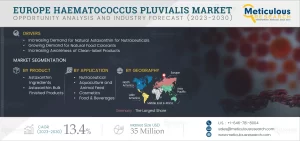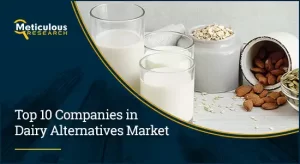The Europe Haematococcus Pluvialis Market is projected to reach $35 million by 2030, at a CAGR of 13.4% during the forecast period of 2023 to 2030.
In recent years, there has been a significant shift in consumer preferences toward natural food products, largely driven by growing health consciousness and a demand for environmentally friendly options. This transformation has prompted food manufacturers to seek alternatives to synthetic additives, particularly in the realm of food colorings. As consumers become increasingly aware of the health hazards associated with artificial production sources, the demand for naturally derived food colors is experiencing unprecedented growth. Among these natural sources, Haematococcus pluvialis, a microalga known for its rich astaxanthin content, stands out as a leading player in the market.
Download Sample Report Here – https://www.meticulousresearch.com/download-sample-report/cp_id=5496

The Growing Demand for Natural Food Colors
The transition from synthetic to natural food colors reflects a broader trend towards clean-label products, which emphasize transparency and simplicity in ingredient lists. Natural food colors are sourced from a variety of origins, including plants, algae, fruits, and even insects, and are prized for their non-toxic properties and minimal side effects. As consumers prioritize health and wellness, food manufacturers are increasingly compelled to enhance their products’ appeal by incorporating natural food colors.
Research shows that the European food and beverage industry, valued at approximately USD 1.2 trillion (EUR 1.1 trillion), is driving significant demand for natural food colorants, particularly those derived from Haematococcus pluvialis. This microalga is revered not only for its vibrant color but also for its health benefits, leading to a marked increase in its application across various sectors.
The Benefits of Natural Astaxanthin
Natural astaxanthin, extracted from Haematococcus pluvialis, offers a range of benefits that make it a preferred choice over synthetic alternatives. Astaxanthin is a powerful antioxidant that has garnered attention for its potential therapeutic properties, which can benefit human health. It is often utilized in dietary supplements and is recognized for its anti-inflammatory effects, making it a valuable addition to nutraceuticals.
In recent years, the safety concerns surrounding synthetic astaxanthin have become more pronounced. Issues related to different stereochemistry and potential carryover of synthesis intermediates have raised alarms about the suitability of synthetic options for direct human consumption. Consequently, the natural form derived from Haematococcus pluvialis has gained favor, particularly in high-end markets that prioritize quality and safety.
Regulatory Support and Market Growth
European regulatory bodies are increasingly endorsing the use of natural food colors, recognizing their biodegradable nature and lower environmental impact. Notably, Haematococcus pluvialis has already received approval as a color additive in fish feeds and dietary supplements across several European countries. However, it’s important to note that while the microalga has been approved for these applications, it has yet to receive approval from the European Food Safety Authority (EFSA) for therapeutic uses.
The U.K. Food Standards Agency (FSA) has granted novel food status to supercritical CO2 extracts from Haematococcus pluvialis, paving the way for broader market acceptance. As a result, the demand for this microalga is projected to surge, particularly in the context of the European market.
Get Insightful Data On Regions, Market Segments, Customer Landscape, And Top Companies (Charts, Tables, Figures And More) :- https://www.meticulousresearch.com/request-sample-report/cp_id=5496
The Clean Label Movement
Consumer demand for clean-label products is reshaping the food industry, emphasizing authenticity and transparency. Clean-label products are defined by their simple, recognizable ingredients, devoid of artificial additives. The clean label movement is particularly influential in driving the demand for natural food colors, as consumers increasingly seek options that align with their health-conscious lifestyles.
A prime example of innovation in this space is the launch of ASTAGILE by Lubrizol Life Science Health, a sustainable, organic-certified astaxanthin derived from Haematococcus pluvialis. This microencapsulated product, recognized for its clean-label attributes, has garnered attention from both manufacturers and consumers alike. As the trend towards health consciousness continues to gain momentum, the demand for clean-label ingredients is expected to drive the growth of the Haematococcus pluvialis market.
Market Projections
According to the latest report by Meticulous Research®, the Haematococcus pluvialis market is projected to reach $35.0 million by 2030, with a compound annual growth rate (CAGR) of 13.4% from 2023 to 2030. In terms of volume, this market is expected to reach 241.44 tons by 2030, growing at a CAGR of 14.5% during the same period. These projections underscore the burgeoning interest in natural astaxanthin and the growing applications of this microalga in the food and beverage sector.
Opportunities and Challenges in the Market
The increasing demand for natural astaxanthin in nutraceuticals and its application in aquaculture and poultry presents significant growth opportunities for stakeholders in the Haematococcus pluvialis market. The rising awareness among consumers about the benefits of natural ingredients is expected to catalyze further growth, particularly in the premium segments of the market.
However, the high production costs associated with cultivating and processing Haematococcus pluvialis pose a challenge for manufacturers. Additionally, the complexity of the production process presents operational hurdles that players in this market must navigate. To address these challenges, companies are exploring innovative production techniques and strategic partnerships to optimize supply chains and enhance cost-efficiency.
Trends in the Haematococcus Pluvialis Market
One notable trend in the Haematococcus pluvialis market is the increasing demand for self-grooming products, which often incorporate natural astaxanthin for its beneficial properties. As consumers become more discerning about the ingredients in their personal care products, the use of natural colorants and additives is likely to gain traction. This trend aligns with the broader movement towards sustainability and wellness, driving demand for natural ingredients across various sectors.
Immediate Delivery Available | BUY THIS RESEARCH REPORT (Insights, Charts, Tables, Figures and More) – https://www.meticulousresearch.com/Checkout/27281564
Segment Covered
Scope of the Report:
Europe Haematococcus Pluvialis Market—by Product
- Astaxanthin Ingredients
- Astaxanthin Oleoresin
- Beadlets
- Whole Biomass Powder
- Water-dispersible Powder
- Astaxanthin Bulk Finished Products
- Capsules/Softgels
- Tablets
Europe Haematococcus Pluvialis Market—by Application
- Nutraceuticals
- Aquaculture and Animal Feed
- Cosmetics
- Food & Beverages
- Pharmaceuticals
Contact:
Meticulous Market Research Pvt. Ltd.
1267 Willis St, Ste 200 Redding,California, 96001, U.S.
USA: +1-646-781-8004
Europe: +44-203-868-8738
APAC: +91 744-7780008
Email– sales@meticulousresearch.com
Visit Our Website: https://www.meticulousresearch.com/
Connect with us on LinkedIn- https://www.linkedin.com/company/meticulous-research






